
|
You entered: Geminids
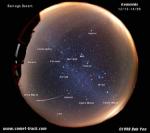 A Geminid from Gemini
A Geminid from Gemini
28.12.1998
The Leonid meteor shower was not the only good meteor shower this season. Earlier this month, the annual Geminids meteor shower peaked, featuring as many as 140 meteors per hour from some locations. Geminid meteors can be seen streaking away from the constellation of Gemini, as depicted in the above all-sky photograph.
 Geminid Fireball over Mount Balang
Geminid Fireball over Mount Balang
16.12.2014
This was a sky to remember. While viewing the Geminids meteor shower a few days ago, a bright fireball was captured over Mt. Balang, China with particularly picturesque surroundings. In the foreground, a sea of light clouds slowly floated between dark mountain peaks.
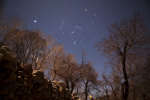 A Geminid Meteor Over Iran
A Geminid Meteor Over Iran
19.12.2011
Some beautiful things begin as grains of sand. Locked in an oyster, a granule grows into an iridescent pearl, lustrous and lovely to behold. While hurtling through the atmosphere at 35 kilometers per second, a generous cosmic sand grain becomes an awe-inspiring meteor, its transient beauty displayed for any who care to watch.
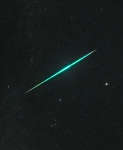 Jupiter and the Geminid
Jupiter and the Geminid
27.12.2023
For a brief moment, this brilliant fireball meteor outshone Jupiter in planet Earth's night. The serendipitous image was captured while hunting meteors under cold Canadian skies with a camera in timelapse mode on December 14, near the peak of the Geminid meteor shower.
 APOD: 2024 December 15 Б Geminid Meteors over a Snowy Forest
APOD: 2024 December 15 Б Geminid Meteors over a Snowy Forest
14.12.2024
Meteors have been flowing out from the constellation Gemini. This was expected, as mid-December is the time of the Geminid Meteor Shower. Pictured here, over two dozen meteors were caught in successively added exposures taken over several hours early Saturday morning from a snowy forest in Poland.
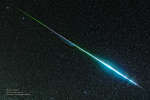 A Rainbow Geminid Meteor
A Rainbow Geminid Meteor
18.12.2018
Meteors can be colorful. While the human eye usually cannot discern many colors, cameras often can. Pictured is a Geminid captured by camera during last week's meteor shower that was not only impressively bright, but colorful.
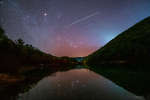 The Geminid
The Geminid
15.12.2022
Returning from beyond the Moon, on December 11 the Orion spacecraft entered Earth's atmosphere at almost 11 kilometers per second. That's half the speed of the grain of dust that created this long fireball meteor when it entered the atmosphere on December 13, near the peak of the annual Geminid meteor shower.
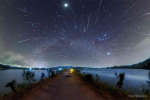 APOD: 2023 December 17 Б Geminids over Chinas Nianhu Lake
APOD: 2023 December 17 Б Geminids over Chinas Nianhu Lake
16.12.2023
Where are all of these meteors coming from? In terms of direction on the sky, the pointed answer is the constellation of Gemini. That is why the major meteor shower in December is known as the Geminids -- because shower meteors all appear to come from a radiant toward Gemini.
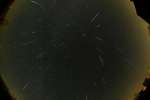 Geminids in 2007
Geminids in 2007
2.01.2008
Dust from curious near-Earth asteroid 3200 Phaethon seems to fall from the constellation Gemini in this fisheye skyview. The composite image was recorded over four December nights (12-15) just last year from Ludanyhalaszi, Hungary. Of course, the streaks are meteor trails from the annual Geminids meteor shower.
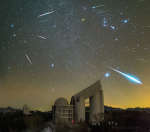 Geminid Meteors over Xinglong Observatory
Geminid Meteors over Xinglong Observatory
12.12.2020
Where do Geminid meteors come from? In terms of location on the sky, as the featured image composite beautifully demonstrates, the sand-sized bits of rock that create the streaks of the Geminids meteor shower appear to flow out from the constellation of Gemini.
|
January February March April |
|||||||||||||||||||||||||||||||||||||||||||||||||